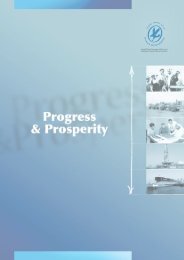4 - Kuwait Oil Company
4 - Kuwait Oil Company
4 - Kuwait Oil Company
Create successful ePaper yourself
Turn your PDF publications into a flip-book with our unique Google optimized e-Paper software.
Significance of Safety Instrumented SystemSubmitted by: Shemej Kumar Kattikolath, Engineer I Design, Design Team, Engineering Groupreduced to an acceptable level. Therefore all risks should be dealt withon the ALARP basis, i.e. the target is to ensure that risk is reduced toAs Low As Reasonably Practicable (ALARP).Shemej Kumar KattikolathEngineer I Design, Design Team, EngineeringGroupSafety and protection of theprocess plants are one of thehighly concerned areas of theplant management and insurancecompanies. Human safety, assetsafety and reputation of theorganization are main areas ofconcerns. Most of the plants aredesigned with inherent processsafety and with additionalindependent protection layers.After conducting Process HazardAnalysis (PHA), Hazard andOperability Study (HAZOP) andQuantitative Risk Assessments(QRA) to find risks involved,additional protection may berequired which shall be achievedthrough Safety InstrumentedSystem (SIS). By implementingSafety Instrumented System,the reliability and availabilityof safety/protection system isensured as and when required.Risk, Safety and HazardSafety can be defined as“freedom from unacceptable risk.”Absolute safety, where risk iscompletely eliminated, can neverbe achieved; risk can only beIf the hazards are not known, the risk cannot be determined. ProcessHazard Analysis (PHA), and Hazard and Operability (HAZOP) studyare carried out to identify the risks and risk levels are quantifiedbased on the respective industry standards and legal regulations. Riskis the combination of the probability of an occurrence of harm and theseverity of that harm.Risk reduction can be considerably achieved by the process selectionand/or engineering design by:• Improving mechanical integrity of the system• Improving the Basic Process Control System (BPCS)• Providing detailed training and operational procedures• Increasing the frequency of proof testing of critical systemcomponents• Implementing safety Instrumented System (SIS)• Implementing mitigating equipmentRisk Reduction LayersRisk reduction layers or Protective layers can be classified as eitherPrevention or Mitigation layers.Protective layers such as alarm system, emergency shutdownsystems, safety relief systems, etc. are put in place to stop hazardousoccurrences and mitigation layers such as fire and gas detectionsystems, deluge systems, etc. are designed to reduce the consequencesafter hazardous events have occurred.October - December 2012 23
















